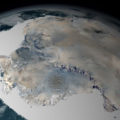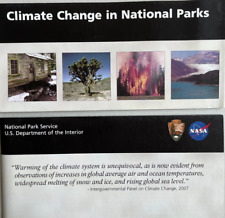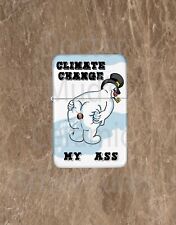
The latest issue of the Proceedings of the National Academy of Sciences describes work by an international team of researchers in identifying small climatic changes that could have large long-term consequences on human and ecological systems. “Society may be lulled into a false sense of security by smooth projections of global change,” the report notes. But, they argue, in some regions anthropogenic forcing on the climate system could kick start abrupt and potentially irreversible changes. For these sub-systems the researchers use the term “tipping element”.
Drawing on a workshop of 36 leading climate scientists in October 2005 at the British Embassy, Berlin, Germany, a further elicitation of 52 experts in the field, and a review of the pertinent literature, the authors compiled a short-list of nine potential tipping elements.
The tipping points, that have been ranked according to likely severity, are:
Highly Sensitive Tipping Elements With The Smallest Uncertainty
- The Greenland Ice Sheet
Warming over the ice sheet accelerates ice loss from outlet glaciers and lowers ice altitude at the periphery, which further increases surface temperature and ablation. The exact tipping point for disintegration of the ice sheet is unknown, since current models cannot capture the observed dynamic deglaciation processes accurately. In a worst case scenario, local warming of more than three degrees Celsius could cause the ice sheet to disappear within 300 years. This would result in a rise of sea level of up to seven meters. - Arctic Sea-Ice
As sea-ice melts, it exposes a much darker ocean surface, which absorbs more radiation than white sea-ice so that the warming is amplified. This causes more rapid melting in summer and decreases ice formation in winter. Over the last 16 years ice cover during summer declined markedly. The critical threshold global mean warming may be between 0.5 to 2 degrees Celsius, but could already have been passed. One model shows a nonlinear transition to a potential new stable state with no arctic sea-ice during summer within a few decades.
Intermediately Sensitive Tipping Elements With A Large Uncertainty
- West Antarctic Ice Sheet
Recent gravity measurements suggest that the ice sheet is losing mass. Since most of the ice sheet is grounded below sea level the intrusion of ocean water could destabilize it. The tipping point could be reached with a local warming of five to eight degrees Celsius in summer. A worst case scenario shows the ice sheet could collapse within 300 years, possibly raising sea level by as much as five meters. - Boreal Forest
The northern forests exhibit a complex interplay between tree physiology, permafrost and fire. A global mean warming of three to five degrees Celsius could lead to large-scale dieback of the boreal forests within 50 years. Under climate change the trees would be exposed to increasing water stress and peak summer heat and would be more vulnerable to diseases. Temperate tree species will remain excluded due to frost damage in very cold winters. - Amazon Rainforest
Global warming and deforestation will probably reduce rainfall in the region by up to 30 percent. Lengthening of the dry season, and increases in summer temperatures would make it difficult for the forest to re-establish. Models project dieback of the Amazon rainforest to occur under three to four degrees Celsius global warming within fifty years. Even land-use change alone could potentially bring forest cover to a critical threshold. - El Niño
The variability of this ocean-atmosphere mode is triggered by the layering of water of different temperatures in the Pacific Ocean and the temperature gradient across the equator. In response to a warmer stabilized climate, the most realistic models simulate increased El Niño amplitude with no clear change in frequency. - Sahara/Sahel And The West African Monsoon
The amount of rainfall is closely related to vegetation climate feedback and sea surface temperatures of the Atlantic Ocean. Greenhouse gas forcing is expected to increase Sahel rainfall. But a global mean warming of three to five degrees Celsius could cause a collapse of the West African monsoon. This could lead either to drying of the Sahel or to wetting due to increased inflow from the West. A third scenario shows a possible doubling of anomalously dry years by the end of the century. - Indian Summer Monsoon
The monsoon circulation is driven by a land-to-ocean pressure gradient. Greenhouse warming tends to strengthen the monsoon since warmer air can carry more water. Air pollution and land-use that increases the reflection of sunlight tend to weaken it. The Indian summer monsoon could become erratic and in the worst case start to chaotically change between an active and a weak phase within a few years.
Lowly Sensitive Tipping Elements With Intermediate Uncertainty
- Atlantic Thermohaline Circulation
The circulation of sea currents in the Atlantic Ocean is driven by seawater that flows to the North Atlantic, cools and sinks at high latitudes. If the inflow of freshwater increases, e.g. from rivers or melting glaciers, or the seawater is warmed, its density would decrease. A global mean warming of three to five degrees Celsius could push the element past the tipping point so that deep water formation stops. Under these conditions the North Atlantic current would be disrupted, sea level in the North Atlantic region would rise and the tropical rain belt would be shifted.
Related:
Missing Fallout Fuels Warming Fears
Arctic Heatwave Sends Climatologists Back To Drawing Board
Asian Brown Clouds Accelerating Warming
Fossil Records Show Yo-Yo Effect Of Changing Climate


















Comments are closed.